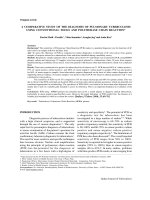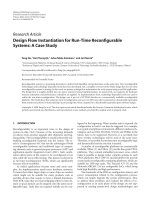asic design flow tutorial using synopsys tools
Bạn đang xem bản rút gọn của tài liệu. Xem và tải ngay bản đầy đủ của tài liệu tại đây (4.52 MB, 130 trang )
San Francisco State University Nano-Electronics & Computing Research Lab
1
ASIC Design Flow Tutorial
Using Synopsys Tools
By
Hima Bindu Kommuru
Hamid Mahmoodi
Nano-Electronics & Computing Research Lab
School of Engineering
San Francisco State University
San Francisco, CA
Spring 2009
San Francisco State University Nano-Electronics & Computing Research Lab
2
TABLE OF CONTENTS
WHAT IS AN ASIC? 5
1.0 INTRODUCTION 5
1.1 CMOS TECHNOLOGY 6
1.2 MOS TRANSISTOR 6
Figure 1.2a MOS Transistor 6
Figure 1.2b Graph of Drain Current vs Drain to Source Voltage 7
1.3 POWER DISSIPATION IN CMOS IC’S 8
1.4 CMOS TRANSMISSION GATE 8
Figure 1.4a Latch 9
Figure 1.4b Flip-Flop 9
OVERVIEW OF ASIC FLOW 10
2.0 INTRODUCTION 10
Figure 2.a : Simple ASIC Design Flow 11
SYNOPSYS VERILOG COMPILER SIMULATOR (VCS) TUTORIAL 13
3.0 INTRODUCTION 13
3.1 TUTORIAL EXAMPLE 14
3.1.1 Compiling and Simulating 14
Figure 3.a: vcs compile 15
Figure 3.b Simulation Result 16
3.2 DVE TUTORIAL 17
APPENDIX 3A: OVERVIEW OF RTL 28
3.A.1 Register Transfer Logic 28
3.A.2 Digital Design 30
APPENDIX 3B: TEST BENCH / VERIFICATION 30
3.B.1 Test Bench Example: 33
DESIGN COMPILER TUTORIAL [RTL-GATE LEVEL SYNTHESIS] 37
4.0 INTRODUCTION 37
4.1 BASIC SYNTHESIS GUIDELINES 39
4.1.1 Startup File 39
4.1.2 Design Objects 40
4.1.3 Technology Library 41
4.1.4 Register Transfer-Level Description 42
4.1.5 General Guidelines 43
4.1.6 Design Attributes and Constraints 44
4.2 TUTORIAL EXAMPLE 46
4.2.1 Synthesizing the Code 48
Figure 4.a : Fragment of analyze command 49
Figure 4.b Fragment of elaborate command 50
Figure 4.c: Fragment of Compile command 53
4.2.2 Interpreting the Synthesized Gate-Level Netlist and Text Reports 54
Figure 4.d : Fragment of area report 55
Figure 4.e: Fragment of cell area report 55
Figure 4.f : Fragment of qor report 56
Figure 4.g: Fragment of Timing report 57
Figure 4.h : Synthesized gate-level netlist 58
4.2.3 SYNTHESIS SCRIPT 58
Note : There is another synthesis example of a FIFO in the below location for further reference. This
synthesized FIFO example is used in the physical design IC Compiler Tutorial 60
APPENDIX 4A: SYNTHESIS OPTIMIZATION TECHNIQUES 60
4. A.0 INTRODUCTION 60
San Francisco State University Nano-Electronics & Computing Research Lab
3
4. A.1 MODEL OPTIMIZATION 60
4.A.1.1 Resource Allocation 60
Figure 4A.b. With resource allocation. 61
4.A.1.2 Flip-flop and Latch optimizations 64
4.A.1.3 Using Parentheses 64
4.A.1.4 Partitioning and structuring the design. 65
4.A.2 OPTIMIZATION USING DESIGN COMPILER 65
4.A.2.1 Top-down hierarchical Compile 66
4.A.2.2 Optimization Techniques 67
4. A.3 TIMING ISSUES 70
Figure 4A.b Timing diagram for setup and hold On DATA 70
4.A.3.1 HOW TO FIX TIMING VIOLATIONS 71
Figure 4A.c : Logic with Q2 critical path 73
Figure 4A.d: Logic duplication allowing Q2 to be an independent path. 73
Figure 4A.e: Multiplexer with late arriving sel signal 74
Figure 4A.f: Logic Duplication for balancing the timing between signals 74
Figure 4.A.g : Logic with pipeline stages 74
4A.4 VERILOG SYNTHESIZABLE CONSTRUCTS 75
5.0 DESIGN VISION 78
5.1 ANALYSIS OF GATE-LEVEL SYNTHESIZED NETLIST USING DESIGN VISION 78
Figure 5.a: Design Vision GUI 78
Figure 5.b: Schematic View of Synthesized Gray Counter 79
Figure 5.c Display Timing Path 81
Figure 5.d Histogram of Timing Paths 81
STATIC TIMING ANALYSIS 82
6.0 INTRODUCTION 82
6.1 TIMING PATHS 82
6.1.1 Delay Calculation of each timing path: 83
6.2 TIMING EXCEPTIONS 83
6.3 SETTING UP CONSTRAINTS TO CALCULATE TIMING: 83
6.4 BASIC TIMING DEFINITIONS: 84
6.5 CLOCK TREE SYNTHESIS (CTS): 85
6.6 PRIMETIME TUTORIAL EXAMPLE 86
6.6.1 Introduction 86
6.6.2 PRE-LAYOUT 86
6.6.2.1 PRE-LAYOUT CLOCK SPECIFICATION 87
6.6.3 STEPS FOR PRE-LAYOUT TIMING VALIDATION 87
IC COMPILER TUTORIAL 92
8.0 BASICS OF PHYSICAL IMPLEMENTATION 92
8.1 Introduction 92
Figure 8.1.a : ASIC FLOW DIAGRAM 92
8.2 FLOORPLANNING 93
Figure 8.2.a : Floorplan example 94
8.3 CONCEPT OF FLATTENED VERILOG NETLIST 97
8.3.a Hierarchical Model: 97
8.3.b Flattened Model: 98
Figure 8.c Floorplanning Flow Chart 98
8.4 PLACEMENT 99
8.5 Routing 100
Figure 8.5.a : Routing grid 101
8.6 PACKAGING 102
Figure 8.6.a : Wire Bond Example 102
San Francisco State University Nano-Electronics & Computing Research Lab
4
Figure 8.6.b : Flip Chip Example 103
8.7 IC TUTORIAL EXAMPLE 103
8.7.1 INTRODUCTION 103
CREATING DESIGN LIBRARY 106
FLOORPLANNING 109
PLACEMENT 112
CLOCK TREE SYNTHESIS 115
CTS POST OPTIMIZATION STEPS 116
ROUTING 117
EXTRACTION 121
9.0 INTRODUCTION 121
APPENDIX A: DESIGN FOR TEST 126
A.0 INTRODUCTION 126
A.1 TEST TECHNIQUES 126
A.1.1 Issues faced during testing 126
A.2 SCAN-BASED METHODOLOGY 126
A.3 FORMAL VERIFICATION 128
APPENDIX B: EDA LIBRARY FORMATS 128
B.1 INTRODUCTION 128
San Francisco State University Nano-Electronics & Computing Research Lab
5
What is an ASIC?
1.0 Introduction
Integrated Circuits are made from silicon wafer, with each wafer holding hundreds of die.
An ASIC is an Application Specific Integrated Circuit. An Integrated Circuit designed
is called an ASIC if we design the ASIC for the specific application. Examples of ASIC
include, chip designed for a satellite, chip designed for a car, chip designed as an
interface between memory and CPU etc. Examples of IC’s which are not called ASIC
include Memories, Microprocessors etc. The following paragraphs will describe the types
of ASIC’s.
1. Full-Custom ASIC: For this type of ASIC, the designer designs all or some of
the logic cells, layout for that one chip. The designer does not used predefined
gates in the design. Every part of the design is done from scratch.
2. Standard Cell ASIC: The designer uses predesigned logic cells such as AND
gate, NOR gate, etc. These gates are called Standard Cells. The advantage of
Standard Cell ASIC’s is that the designers save time, money and reduce the risk
by using a predesigned and pre-tested Standard Cell Library. Also each Standard
Cell can be optimized individually. The Standard Cell Libraries is designed using
the Full Custom Methodology, but you can use these already designed libraries in
the design. This design style gives a designer the same flexibility as the Full
Custom design, but reduces the risk.
3. Gate Array ASIC: In this type of ASIC, the transistors are predefined in the
silicon wafer. The predefined pattern of transistors on the gate array is called a
base array and the smallest element in the base array is called a base cell. The
base cell layout is same for each logic cell, only the interconnect between the cells
and inside the cells is customized. The following are the types of gate arrays:
a. Channeled Gate Array
b. Channelless Gate Array
C. Structured Gate Array
When designing a chip, the following objectives are taken into consideration:
1. Speed
2. Area
3. Power
4. Time to Market
To design an ASIC, one needs to have a good understanding of the CMOS Technology.
The next few sections give a basic overview of CMOS Technology.
San Francisco State University Nano-Electronics & Computing Research Lab
6
1.1 CMOS Technology
In the present decade the chips being designed are made from CMOS technology. CMOS
is Complementary Metal Oxide Semiconductor. It consists of both NMOS and PMOS
transistors. To understand CMOS better, we first need to know about the MOS (FET)
transistor.
1.2 MOS Transistor
MOS stands for Metal Oxide Semiconductor field effect transistor. MOS is the basic
element in the design of a large scale integrated circuit is the transistor. It is a voltage
controlled device. These transistors are formed as a ``sandwich'' consisting of a
semiconductor layer, usually a slice, or wafer, from a single crystal of silicon; a layer of
silicon dioxide (the oxide) and a layer of metal. These layers are patterned in a manner
which permits transistors to be formed in the semiconductor material (the ``substrate'');
The MOS transistor consists of three regions, Source, Drain and Gate. The source and
drain regions are quite similar, and are labeled depending on to what they are connected.
The source is the terminal, or node, which acts as the source of charge carriers; charge
carriers leave the source and travel to the drain. In the case of an N channel MOSFET
(NMOS), the source is the more negative of the terminals; in the case of a P channel
device (PMOS), it is the more positive of the terminals. The area under the gate oxide is
called the ``channel”. Below is figure of a MOS Transistor.
Figure 1.2a MOS Transistor
The transistor normally needs some kind of voltage initially for the channel to form.
When there is no channel formed, the transistor is said to be in the ‘cut off region’. The
voltage at which the transistor starts conducting (a channel begins to form between the
source and the drain) is called threshold Voltage. The transistor at this point is said to be
in the ‘linear region’. The transistor is said to go into the ‘saturation region’ when there
are no more charge carriers that go from the source to the drain.
San Francisco State University Nano-Electronics & Computing Research Lab
7
Figure 1.2b Graph of Drain Current vs Drain to Source Voltage
CMOS technology is made up of both NMOS and CMOS transistors. Complementary
Metal-Oxide Semiconductors (CMOS) logic devices are the most common devices used
today in the high density, large number transistor count circuits found in everything from
complex microprocessor integrated circuits to signal processing and communication
circuits. The CMOS structure is popular because of its inherent lower power
requirements, high operating clock speed, and ease of implementation at the transistor
level. The complementary p-channel and n-channel transistor networks are used to
connect the output of the logic device to the either the V
DD
or V
SS
power supply rails for a
given input logic state. The MOSFET transistors can be treated as simple switches. The
switch must be on (conducting) to allow current to flow between the source and drain
terminals.
Example: Creating a CMOS inverter requires only one PMOS and one NMOS transistor.
The NMOS transistor provides the switch connection (ON) to ground when the input is
logic high. The output load capacitor gets discharged and the output is driven to a
logic’0’. The PMOS transistor (ON) provides the connection to the V
DD
power supply
rail when the input to the inverter circuit is logic low. The output load capacitor gets
charged to V
DD .
The output is driven to logic ’1’.
The output load capacitance of a logic gate is comprised of
a. Intrinsic Capacitance: Gate drain capacitance ( of both NMOS and PMOS
transistors)
b. Extrinsic Capacitance: Capacitance of connecting wires and also input
capacitance of the Fan out Gates.
In CMOS, there is only one driver, but the gate can drive as many gates as possible. In
CMOS technology, the output always drives another CMOS gate input.
The charge carriers for PMOS transistors is ‘holes’ and charge carriers for NMOS
are electrons. The mobility of electrons is two times more than that of ‘holes’. Due to this
the output rise and fall time is different. To make it same, the W/L ratio of the PMOS
transistor is made about twice that of the NMOS transistor. This way, the PMOS and
San Francisco State University Nano-Electronics & Computing Research Lab
8
NMOS transistors will have the same ‘drive strength’. In a standard cell library, the
length ‘L’ of a transistor is always constant. The width ‘W’ values are changed to have to
different drive strengths for each gate. The resistance is proportional to (L/W). Therefore
if the increasing the width, decreases the resistance.
1.3 Power Dissipation in CMOS IC’s
The big percentage of power dissipation in CMOS IC’s is due to the charging and
discharging of capacitors. Majority of the low power CMOS IC designs issue is to reduce
power dissipation. The main sources of power dissipation are:
1. Dynamic Switching Power: due to charging and discharging of circuit
capacitances
A low to high output transition draws energy from the power supply
A high to low transition dissipates energy stored in CMOS transistor.
Given the frequency ‘f’, of the low-high transitions, the total power drawn
would be: load capacitance*Vdd*Vdd*f
2. Short Circuit Current: It occurs when the rise/fall time at the input of the gate is
larger than the output rise/fall time.
3. Leakage Current Power: It is caused by two reasons;
a. Reverse-Bias Diode Leakage on Transistor Drains: This happens in
CMOS design, when one transistor is off, and the active transistor charges
up/down the drain using the bulk potential of the other transistor.
Example: Consider an inverter with a high input voltage, output is low
which means NMOS is on and PMOS is off. The bulk of PMOS is
connected to VDD. Therefore there is a drain-to –bulk voltage –VDD,
causing the diode leakage current.
b. Sub-Threshold Leakage through the channel to an ‘OFF’ transistor/device.
1.4 CMOS Transmission Gate
A PMOS transistor is connected in parallel to a NMOS transistor to form a Transmission
gate. The transmission gate just transmits the value at the input to the output. It consists
of both NMOS and PMOS because, PMOS transistor transmits a strong ‘1’ and NMOS
transistor transmits a strong ‘0’. The advantages of using a Transmission Gate are:
1. It shows better characteristics than a switch.
2. The resistance of the circuit is reduced, since the transistors are connected in parallel.
Sequential Element
In CMOS, an element which stores a logic value (by having a feedback loop) is called a
sequential element. A simplest example of a sequential element would be two inverters
connected back to back. There are two types of basic sequential elements, they are:
1. Latch: The two inverters connected back to back, when connected to a
transmission gate, with a control input, forms a latch. When the control input is
high (logic ‘1’), the transmission gate is switched on and whatever value which
was at the input ‘D’ passes to the output. When the control input is low, the
transmission gate is off and the inverters that are connected back to back hold the
San Francisco State University Nano-Electronics & Computing Research Lab
9
value. Latch is called a transparent latch because when the ‘D’ input changes, the
output also changes accordingly.
Figure 1.4a Latch
2. Flip-Flop: A flip flop is constructed from two latches in series. The first latch is
called a Master latch and the second latch is called the slave latch. The control
input to the transmission gate in this case is called a clock. The inverted version of
the clock is fed to the input of the slave latch transmission gate.
a. When the clock input is high, the transmission gate of the master latch is
switched on and the input ‘D’ is latched by the 2 inverters connected back
to back (basically master latch is transparent). Also, due to the inverted
clock input to the transmission gate of the slave latch, the transmission
gate of the slave latch is not ‘on’ and it holds the previous value.
b. When the clock goes low, the slave part of the flip flop is switched on and
will update the value at the output with what the master latch stored when
the clock input was high. The slave latch will hold this new value at the
output irrespective of the changes at the input of Master latch when the
clock is low. When the clock goes high again, the value at the output of
the slave latch is stored and step’a’ is repeated again.
The data latched by the Master latch in the flip flop happens at the rising clock
edge, this type of flip flop is called positive-edge triggered flip flop. If the latching
happens at negative edge of the clock, the flip flop is called negative edge triggered flip
flop.
CLK
D
Q
Master Slave
Figure 1.4b Flip-Flop
San Francisco State University Nano-Electronics & Computing Research Lab
10
Overview of ASIC Flow
2.0 Introduction
To design a chip, one needs to have an Idea about what exactly one wants to design. At
every step in the ASIC flow the idea conceived keeps changing forms. The first step to
make the idea into a chip is to come up with the Specifications.
Specifications are nothing but
• Goals and constraints of the design.
• Functionality (what will the chip do)
• Performance figures like speed and power
• Technology constraints like size and space (physical dimensions)
• Fabrication technology and design techniques
The next step is in the flow is to come up with the Structural and Functional
Description. It means that at this point one has to decide what kind of architecture
(structure) you would want to use for the design, e.g. RISC/CISC, ALU, pipelining etc …
To make it easier to design a complex system; it is normally broken down into several
sub systems. The functionality of these subsystems should match the specifications. At
this point, the relationship between different sub systems and with the top level system is
also defined.
The sub systems, top level systems once defined, need to be implemented. It is
implemented using logic representation (Boolean Expressions), finite state machines,
Combinatorial, Sequential Logic, Schematics etc This step is called Logic Design /
Register Transfer Level (RTL). Basically the RTL describes the several sub systems. It
should match the functional description. RTL is expressed usually in Verilog or VHDL.
Verilog and VHDL are Hardware Description Languages. A hardware description
language (HDL) is a language used to describe a digital system, for example, a network
switch, a microprocessor or a memory or a simple flip-flop. This just means that, by
using a HDL one can describe any hardware (digital) at any level. Functional/Logical
Verification is performed at this stage to ensure the RTL designed matches the idea.
Once Functional Verification is completed, the RTL is converted into an optimized
Gate Level Netlist. This step is called Logic/RTL synthesis. This is done by Synthesis
Tools such as Design Compiler (Synopsys), Blast Create (Magma), RTL Compiler
(Cadence) etc A synthesis tool takes an RTL hardware description and a standard cell
library as input and produces a gate-level netlist as output. Standard cell library is the
basic building block for today’s IC design. Constraints such as timing, area, testability,
and power are considered. Synthesis tools try to meet constraints, by calculating the cost
of various implementations. It then tries to generate the best gate level implementation
for a given set of constraints, target process. The resulting gate-level netlist is a
completely structural description with only standard cells at the leaves of the design. At
this stage, it is also verified whether the Gate Level Conversion has been correctly
performed by doing simulation.
The next step in the ASIC flow is the Physical Implementation of the Gate Level
Netlist. The Gate level Netlist is converted into geometric representation. The geometric
San Francisco State University Nano-Electronics & Computing Research Lab
11
representation is nothing but the layout of the design. The layout is designed according to
the design rules specified in the library. The design rules are nothing but guidelines based
on the limitations of the fabrication process. The Physical Implementation step consists
of three sub steps; Floor planning->Placement->Routing. The file produced at the output
of the Physical Implementation is the GDSII file. It is the file used by the foundry to
fabricate the ASIC. This step is performed by tools such as Blast Fusion (Magma), IC
Compiler (Synopsys), and Encounter (Cadence) Etc…Physical Verification is performed
to verify whether the layout is designed according the rules.
Figure 2.a : Simple ASIC Design Flow
Idea
Specifications
RTL
Gate Level Netlist
Physical
Implementation
GDSII
CHIP
San Francisco State University Nano-Electronics & Computing Research Lab
12
For any design to work at a specific speed, timing analysis has to be performed.
We need to check whether the design is meeting the speed requirement mentioned in the
specification. This is done by Static Timing Analysis Tool, for example Primetime
(Synopsys). It validates the timing performance of a design by checking the design for all
possible timing violations for example; set up, hold timing.
After Layout, Verification, Timing Analysis, the layout is ready for Fabrication. The
layout data is converted into photo lithographic masks. After fabrication, the wafer is
diced into individual chips. Each Chip is packaged and tested.
San Francisco State University Nano-Electronics & Computing Research Lab
13
Synopsys Verilog Compiler Simulator (VCS) Tutorial
3.0 Introduction
Synopsys Verilog Compiler Simulator is a tool from Synopsys specifically designed to
simulate and debug designs. This tutorial basically describes how to use VCS, simulate a
verilog description of a design and learn to debug the design. VCS also uses VirSim,
which is a graphical user interface to VCS used for debugging and viewing the
waveforms.
There are three main steps in debugging the design, which are as follows
1. Compiling the Verilog/VHDL source code.
2. Running the Simulation.
3. Viewing and debugging the generated waveforms.
You can interactively do the above steps using the VCS tool. VCS first compiles the
verilog source code into object files, which are nothing but C source files. VCS can
compile the source code into the object files without generating assembly language files.
VCS then invokes a C compiler to create an executable file. We use this executable file to
simulate the design. You can use the command line to execute the binary file which
creates the waveform file, or you can use VirSim.
Below is a brief overview of the VCS tool, shows you how to compile and simulate a
counter. For basic concepts on verification and test bench, please refer to APPENDIX 3A
at the end of this chapter.
SETUP
Before going to the tutorial Example, let’s first setup up the directory.
You need to do the below 3 steps before you actually run the tool:
1. As soon as you log into your engr account, at the command prompt, please type “csh
“as shown below. This changes the type of shell from bash to c-shell. All the commands
work ONLY in c-shell.
[hkommuru@hafez ]$csh
2. Please copy the whole directory from the below location (cp –rf source destination)
[hkommuru@hafez ]$cd
[hkommuru@hafez ]$ cp -rf /packages/synopsys/setup/asic_flow_setup ./
This creates directory structure as shown below. It will create a directory called
“asic_flow_setup ”, under which it creates the following directories namely
San Francisco State University Nano-Electronics & Computing Research Lab
14
asic_flow_setup
src/ : for verilog code/source code
vcs/ : for vcs simulation ,
synth_graycounter/ : for synthesis
synth_fifo/ : for synthesis
pnr/ : for Physical design
extraction/: for extraction
pt/: for primetime
verification/: final signoff check
The “asic_flow_setup” directory will contain all generated content including, VCS
simulation, synthesized gate-level Verilog, and final layout. In this course we will always
try to keep generated content from the tools separate from our source RTL. This keeps
our project directories well organized, and helps prevent us from unintentionally
modifying the source RTL. There are subdirectories in the project directory for each
major step in the ASIC Flow tutorial. These subdirectories contain scripts and
configuration files for running the tools required for that step in the tool flow. For this
tutorial we will work exclusively in the vcs directory.
3. Please source “synopsys_setup.tcl” which sets all the environment variables necessary
to run the VCS tool.
Please source them at unix prompt as shown below
[hkommuru@hafez ]$ source /packages/synopsys/setup/synopsys_setup.tcl
Please Note : You have to do all the three steps above everytime you log in.
3.1 Tutorial Example
In this tutorial, we would be using a simple counter example . Find the verilog code and
testbench at the end of the tutorial.
Source code file name : counter.v
Test bench file name : counter_tb.v
Setup
3.1.1 Compiling and Simulating
NOTE: AT PRESENT THERE SEEMS TO BE A BUG IN THE TOOL, SO
COMPILE AND SIMULATION IN TWO DIFFERENT STEPS IS NOT
WORKING. THIS WILL BE FIXED SHORTLY. PLEASE DO STEP 3 TO SEE
THE OUTPUT OF YOUR CODE. STEP 3 COMMAND PERFORMS
COMPILATION AND SIMULATION IN ONE STEP.
San Francisco State University Nano-Electronics & Computing Research Lab
15
1. In the “vcs” directory, compile the verilog source code by typing the following at the
machine prompt.
[hkommuru@hafez vcs]$ cd asic_flow_setup/vcs
[hkommuru@hafez vcs]$ cp /src/counter/* .
[hkommuru@hafez vcs]$ vcs –f main_counter.f +v2k
Please note that the –f option means the file specified (main_counter.f ) contains a list of
command line options for vcs. In this case, the command line options are just a list of the
verilog file names. Also note that the testbench is listed first. The below command also
will have same effect .
[hkommuru@hafez vcs]$ vcs –f counter_tb.v counter.v +v2k
The +v2k option is used if you are using Verilog IEE 1364-2000 syntax; otherwise there
is no need for the option. Please look at Figure 3.a for output of compile command.
Figure 3.a: vcs compile
Chronologic VCS (TM)
Version B-2008.12 Wed Jan 28 20:08:26 2009
Copyright (c) 1991-2008 by Synopsys Inc.
ALL RIGHTS RESERVED
This program is proprietary and confidential information of Synopsys Inc.
and may be used and disclosed only as authorized in a license agreement
controlling such use and disclosure.
Warning-[ACC_CLI_ON] ACC/CLI capabilities enabled
ACC/CLI capabilities have been enabled for the entire design. For faster
performance enable module specific capability in pli.tab file
Parsing design file 'counter_tb.v'
Parsing design file 'counter.v'
Top Level Modules:
timeunit
counter_testbench
TimeScale is 1 ns / 10 ps
Starting vcs inline pass
2 modules and 0 UDP read.
recompiling module timeunit
recompiling module counter_testbench
Both modules done.
gcc -pipe -m32 -O -I/packages/synopsys/vcs_mx/B-2008.12/include -c -o rmapats.o rmapats.c
if [ -x /simv ]; then chmod -x /simv; fi
g++ -o /simv -melf_i386 -m32 5NrI_d.o 5NrIB_d.o IV5q_1_d.o blOS_1_d.o rmapats_mop.o rmapats.o
SIM_l.o /packages/synopsys/vcs_mx/B-2008.12/linux/lib/libvirsim.a /packages/synopsys/vcs_mx/B-
2008.12/linux/lib/librterrorinf.so /packages/synopsys/vcs_mx/B-2008.12/linux/lib/libsnpsmalloc.so
San Francisco State University Nano-Electronics & Computing Research Lab
16
/packages/synopsys/vcs_mx/B-2008.12/linux/lib/libvcsnew.so /packages/synopsys/vcs_mx/B-
2008.12/linux/lib/ctype-stubs_32.a -ldl -lz -lm -lc -ldl
/simv up to date
VirSim B-2008.12-B Virtual Simulator Environment
Copyright (C) 1993-2005 by Synopsys, Inc.
Licensed Software. All Rights Reserved.
By default the output of compilation would be a executable binary file is named simv.
You can specify a different name with the -o compile-time option.
For example :
vcs –f main_counter.f +v2k –o counter.simv
VCS compiles the source code on a module by module basis. You can incrementally
compile your design with VCS, since VCS compiles only the modules which have
changed since the last compilation.
2. Now, execute the simv command line with no arguments. You should see the output
from both vcs and simulation and should produce a waveform file called counter.dump in
your working directory.
[hkommuru@hafez vcs]$./counter.simv
Please see Figure 3.b for output of simv command
Figure 3.b Simulation Result
Chronologic VCS simulator copyright 1991-2008
Contains Synopsys proprietary information.
Compiler version B-2008.12; Runtime version B-2008.12; Jan 28 19:59 2009
time= 0 ns, clk=0, reset=0, out=xxxx
time= 10 ns, clk=1, reset=0, out=xxxx
time= 11 ns, clk=1, reset=1, out=xxxx
time= 20 ns, clk=0, reset=1, out=xxxx
time= 30 ns, clk=1, reset=1, out=xxxx
time= 31 ns, clk=1, reset=0, out=0000
time= 40 ns, clk=0, reset=0, out=0000
time= 50 ns, clk=1, reset=0, out=0000
time= 51 ns, clk=1, reset=0, out=0001
time= 60 ns, clk=0, reset=0, out=0001
time= 70 ns, clk=1, reset=0, out=0001
time= 71 ns, clk=1, reset=0, out=0010
time= 80 ns, clk=0, reset=0, out=0010
time= 90 ns, clk=1, reset=0, out=0010
time= 91 ns, clk=1, reset=0, out=0011
time= 100 ns, clk=0, reset=0, out=0011
time= 110 ns, clk=1, reset=0, out=0011
time= 111 ns, clk=1, reset=0, out=0100
San Francisco State University Nano-Electronics & Computing Research Lab
17
time= 120 ns, clk=0, reset=0, out=0100
time= 130 ns, clk=1, reset=0, out=0100
time= 131 ns, clk=1, reset=0, out=0101
time= 140 ns, clk=0, reset=0, out=0101
time= 150 ns, clk=1, reset=0, out=0101
time= 151 ns, clk=1, reset=0, out=0110
time= 160 ns, clk=0, reset=0, out=0110
time= 170 ns, clk=1, reset=0, out=0110
All tests completed sucessfully
$finish called from file "counter_tb.v", line 75.
$finish at simulation time 171.0 ns
V C S S i m u l a t i o n R e p o r t
Time: 171000 ps
CPU Time: 0.020 seconds; Data structure size: 0.0Mb
Wed Jan 28 19:59:54 2009
If you look at the last page of the tutorial, you can see the testbench code, to understand
the above result better.
3. You can do STEP 1 and STEP 2 in one single step below. It will compile and simulate
in one single step. Please take a look at the command below:
[hkommuru@hafez vcs]$ vcs -V -R -f main_counter.f -o simv
In the above command,
-V : stands for Verbose
-R : command which tells the tool to do simulation immediately/automatically after
compilation
-o : output file name , can be anything simv, counter.simv etc
-f : specifying file
To compile and simulate your design, please write your verilog code, and copy it to the
vcs directory. After copying your verilog code to the vcs directory, follow the tutorial
steps to simulate and compile.
3.2 DVE TUTORIAL
DVE provides you a graphical user interface to debug your design. Using DVE you can
debug the design in interactive mode or in postprocessing mode. In the interactive mode,
apart from running the simulation, DVE allows you to do the following:
• View waveforms
• Trace Drivers and loads
• Schematic, and Path Schematic view
• Compare waveforms
• Execute UCLI/Tcl commands
• Set line, time, or event break points
• Line stepping
San Francisco State University Nano-Electronics & Computing Research Lab
18
However, in post-processing mode, a VPD/VCD/EVCD file is created during simulation,
and you use DVE to:
• View waveforms
• Trace Drivers and loads
• Schematic, and Path Schematic view
• Compare waveforms
Use the below command line to invoke the simulation in interactive mode using DVE:
[hkommuru@hafez vcs]$simv –gui
A TopLevel window is a frame that displays panes and views.
• A pane can be displayed one time on each TopLevel Window. serves a specific debug
purpose. Examples of panes are Hierarchy, Data, and the Console panes.
• A view can have multiple instances per TopLevel window. Examples of views are
Source, Wave, List, Memory, and Schematic. Panes can be docked on any side to a
TopLevel window or left floating in the area in the frame not occupied by docked panes
(called the workspace).
You can use the above command or you can do everything, which is compile and
simulation, open the gui in one step.
1. Invoke dve to view the waveform. At the unix prompt, type :
[hkommuru@hafez vcs]$ vcs -V -R -f main_counter.f -o simv -gui –debug_pp
Where debug_pp option is used to run the dve in simulation mode. Debug_pp creates a
vpd file which is necessary to do simulation. The below window will open up.
San Francisco State University Nano-Electronics & Computing Research Lab
19
2. In the above window, open up the counter module to view the whole module like
below. Click on dut highlighted in blue and drag it to the data pane as shown below. All
the signals in the design will show up in the data pane.
San Francisco State University Nano-Electronics & Computing Research Lab
20
3. In this window, click on “Setup” under the “Simulator” option. A new small window
will open up as shown. Inter.vpd is the file, the simulator will use to run the waveform.
San Francisco State University Nano-Electronics & Computing Research Lab
21
The –debug_pp option in step1 creates this file. Click ok and now the step up is complete
to run the simulation shown in the previous page.
4. Now in the data pane select all the signals with the left mouse button holding the shift
button so that you select as many signals you want. Click on the right mouse button to
open a new window, and click on “Add to group => New group . A new window will
open up showing a new group of selected signals below.
You can create any number of signal groups you want so that you can organize the way
and you want to see the output of the signals .
San Francisco State University Nano-Electronics & Computing Research Lab
22
5. 4. Now in the data pane select all the signals with the left mouse button holding the
shift button so that you select as many signals you want. Click on the right mouse button
to open a new window, and click on “Add to waves New wave view”. A new
waveform window will open with simulator at 0ns .
San Francisco State University Nano-Electronics & Computing Research Lab
23
6. In the waveform window, go to “Simulator menu option” and click on “Start”. The tool
now does simulation and you can verify the functionality of the design as shown below.
In the waveform window, the menu option View Set Time Scale can be used to
change the display unit and the display precision
7. You can save your current session and reload the same session next time or start a new
session again. In the menu option , File Save Session, the below window opens as
shown below.
San Francisco State University Nano-Electronics & Computing Research Lab
24
8. For additional debugging steps, you can go to menu option
1. Scope Show Source code: You can view your source code here and analyze.
2. Scope Show Schematic: You can view a schematic view of the design .
San Francisco State University Nano-Electronics & Computing Research Lab
25
9. Adding Breakpoints in Simulation. To be able to add breakpoints, you have to use a
additional compile option –debug_all –flag when you compile the code as shown below.
[hkommuru@hafez vcs]$ vcs -V -R -f main_counter.f -o simv -gui –debug_pp -
debug_all –flag
Go to the menu option, Simulation Breakpoints , will open up a new window as shown
below. You need to do this before Step 6, i.e. before actually running the simulation.
You can browse which file and also the line number and click on “Create” button to
create breakpoints.
Now when you simulate, click on Simulate Start, it will stop at your defined
breakpoint, click on Next to continue.
You can save your session again and exit after are done with debugging or in the middle
of debugging your design.
Verilog Code
File : Counter.v
module counter ( out, clk, reset ) ;









